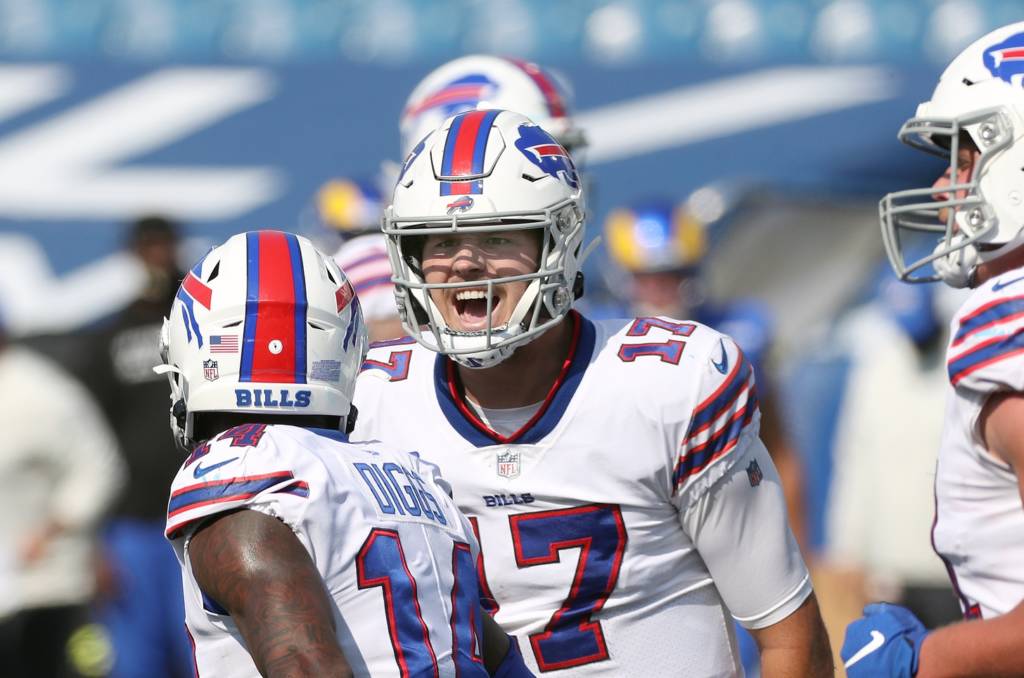The old quarterback-wide receiver conversation has risen again. Who made who? Would one be good without the other? He only makes that type of money because he has that guy as his quarterback!!
In recent weeks this conversation has made its way to One Bills Drive in Orchard Park, and Josh Allen and Stefon Diggs are in the middle of it, of course.
Like every debate these days, this one started on social media with someone saying that Diggs was the only reason Allen was a top-five quarterback in 2020. Then, in typical Bills Mafia fashion, someone responded with the opposite accusation.
“Josh Allen made Stefon Diggs.”
The Allen-Diggs connection was one of the best in the NFL last year, and while some may have thought of it as one making the other better, their relationship was essentially a two-way street. They both contributed to each other’s meteoric rise through the league ranks.
Allen was a sub-par passer in his first two years in the league. He completed just 52.8 percent of his passes as a rookie and 58.8 percent of his passes in his second year. He relied on his legs a lot during his first year in the league, running for 631 yards and eight touchdowns, compared to 2,074 passing yards and 10 touchdowns.
But the former Wyoming quarterback still took a step forward in 2019. He passed for 3,089 yards and 20 touchdowns and both Cole Beasley and John Brown, who came into the season looking to prove themselves as top-tier receivers, had career seasons during their first year in Buffalo.
Beasley caught a career-high six touchdowns and Brown recorded a career-high 1,060 receiving yards.
As Allen settled into the competition level in the NFL, after playing in the Mountain West Conference at Wyoming, his improvement was evident. His numbers climbed from his rookie to his sophomore year. So what can help a young quarterback even more?
How about a stud receiver?
Bills general manager Brandon Beane pulled off a blockbuster trade with the Minnesota Vikings to land Diggs ahead of the 2020 season, and Allen immediately took a step forward. Believe it or not, adding a guy like Diggs to an already talented receiver room will do that.
Diggs was also looking for a new start too, though.
He was coming off his fifth year in Minnesota where he caught 63 passes, the second-lowest of his career. But he went off for 1,130 yards, the highest total of his career before this season. With the Vikings leaning on Dalvin Cook in a run-heavy offense, Diggs wasn’t getting targeted nearly as much as he had hoped after signing a five-year, $81 million extension in 2018.
So, the former Terrapin essentially forced his way out of Minnesota and linked up with Allen in Buffalo. He quickly became the most-targeted receiver in the league and had a career-high 127 receptions for 1,535 yards this past season, both league-highs.
Yes, Diggs benefitted from Allen’s performance this past season. But the feeling was mutual as the Bills franchise quarterback was top-five in the league with 4,544 passing yards and 37 touchdowns while completing 69.2% of his passes, a 10-point jump from his sophomore season.
Both Allen and Diggs benefitted from the other’s presence. It was a two-way street. Not one over the other. But that’s not the only reason that these two made a meteoric rise this past season.
Obviously, Allen’s accuracy was a big piece of the puzzle. His completion percentage jumped 10 points, which is astronomical and is one of the biggest reasons he played as well as he did. He only had four games where his completion percentage was below 65% and that benefitted his receivers as well. Both Diggs and Beasley had the best seasons of their career, combining for 2,502 receiving yards.
Buffalo’s offensive approach was the key factor in the pair’s rise this season. Diggs and Allen could’ve improved their individual skills as much as they wanted to during the offseason, but without Brian Daboll’s offensive scheme this past season, neither of them would’ve taken the jump that they did.
Since Sean McDermott took over in Buffalo, the Bills had focused primarily on playing solid defense and controlling the possession with a strong run game.
During McDermott’s first three years in Buffalo, the Bills had a top-10 rushing offense. But this past season, that changed meaningfully. They changed to a pass-heavy offense and put together the 20th-best rushing attack in the league.
The relationship Allen and Diggs built helped as well.
Even during a season where they had to deal with the coronavirus pandemic and interactions were limited, the pair found a way to build a bond that helped them take another step this season. They talked multiple times throughout this season about playing Call of Duty together in their downtime, along with other pandemic-safe ways to build their relationship.
It all translated to a top-tier product on the field. With several things factored in, Diggs and Allen helped each other out, it wasn’t one way or the other.

